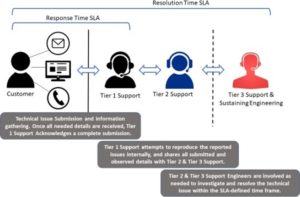Visual Lease Service Level Agreement
Summary
Visual Lease’s Service Level Agreement (SLA) governs its responsibilities to its hosted customers in the Production environment, in the areas of: Service Availability, Technical Issue Response &e Resolution, and Disaster Recovery.
This SLA shall be incorporated by reference into the Agreement. In the event of any inconsistency or conflict between the terms and conditions of this SLA and the Agreement, the terms and conditions of this SLA shall govern with respect to the subject matter of this SLA only. Capitalized terms used in this SLA shall have the meaning defined under the Agreement.
Service Availability (Uptime)
Uptime Commitment
Service Availability, or Uptime, is measured as the percentage of total time the hosted services were available during a specific calendar month, when excluding all planned downtime. Planned downtime is defined as the total amount of time hosted services are inaccessible during a monthly period due to maintenance, whether it be Scheduled or Emergency maintenance.
- Visual Lease commits to a monthly Uptime of: 99.5%
Uptime Exclusions and Limitations
This Uptime commitment is exclusively for Production environments, and excludes the following:
- Non-production environments like: Test, Preview, Stage, Early Access, Sandbox, or other limited functionality environments
- Periods of inaccessibility due to communicated infrastructure or software maintenance
- Service disruptions lasting less than 5 minutes
- Slowness or other performance issues with the application
- Issues related to non-Visual Lease applications including integrations
- External network or equipment problems outside of Visual Lease’s reasonable control, such as bad routing tables between your internet service provider (ISP) and hosting servers, or customer-managed local-area-networks (LANs).
- Any other issue outside of Visual Lease’s reasonable
Maintenance Schedules & Communication
Visual Lease will communicate both Scheduled Maintenance & Emergency Maintenance through in- application messaging. Visual Lease will communicate maintenance as follows:
- Scheduled Maintenance is a planned period where hosting infrastructure or application version are upgraded, or some other corrective action is To the extent practicable, these periods are generally during non-business hours, and will be communicated at least 8 hours in advance to customers. Although it typically requires much less time, Visual Lease reserves up to 8 hours per week for scheduled maintenance.
- Emergency Maintenance is an urgent maintenance action taken to prevent or remedy conditions likely to cause service disruptions if left unresolved. Emergency maintenance may
include but is not limited to efforts to address platform (hardware, network or firmware) or application (software or database) issues or vulnerabilities. Emergency Maintenance periods will be communicated as promptly as possible to minimize service interruptions. Visual Lease will endeavor to perform emergency maintenance during non-business hours whenever feasible.
The following table reflects the standard Visual Lease Scheduled Maintenance windows for production environments. Visual Lease will communicate scheduled maintenance in advance, and reserves the right to change this schedule at any time.
| Frequency | Scheduling | Time |
|---|---|---|
| Bi-Weekly | Saturday | 8am – 3pm (ET) |
| Monthly | Saturday | 10pm – 1am (ET) |
| Weekly | Wednesday | 10pm – 1am (ET) |
Uptime Service Credits
In the event Visual Lease falls short of reaching its 99.5% Uptime Commitment in a given calendar month, and your workspace is affected, then Visual Lease shall credit a percentage of the monthly fee as described below:
| Monthly Uptime Percentage | Service Credits Percentage |
|---|---|
| <99.5% to 97.0% | Equal to 5% of the impacted product’s recurring billing payable by the Customer to Visual Lease for the month in question |
| <97.0 to 95.0% | Equal to 10% of the impacted product’s recurring billing payable by the Customer to Visual Lease for the month in question |
Visual Lease utilizes monitoring software to accurately track Uptime of its Production applications and services. Visual Lease customers may request once annually, in writing, an Uptime Report for the most recent completed calendar year’s service period only. To receive a service credit, customers must then request the service credit in writing for any particular month that was affected, within thirty (30) days after receipt of such year’s Uptime report from Visual Lease. To be eligible to receive a service credit, customers must be active Visual Lease customers, in good standing, and fully current on any outstanding invoices
Service Credits are not refunds, cannot be exchanged into a cash amount, and are applied to future payments. These credits are capped at a maximum of 10% of the monthly paid service. Service Credits are the sole and exclusive remedy for any failure by Visual Lease to meet its Service Availability (Uptime) obligations under this SLA.
Technical Issues
A technical issue is defined as a problematic application error or state impacting customer usage which causes the software to perform contrary to Visual Lease’s then-current documentation. Customer- submitted support cases requesting a feature, training, questions, or other support are not considered technical issues and are not governed by this SLA document.
Visual Lease categorizes technical issues by severity using the below four-tier scale. This objective scale is based on business impact and governs technical issue response and resolution time targets by Visual Lease to the customer. Technical Issue Severity definitions relate solely to Production environment issues only. All non-Production Technical Issues shall be automatically set to Severity 3 (Medium) or Severity 4 (Low).
· Severity 1 (Critical):
An application error or state causing a total loss of functionality that renders the application completely inaccessible or unusable. No workaround is available.
· Severity 2 (High):
An application error or state causing a substantial loss of functionality that renders that application usable but in a severely degraded state. This degraded state impacts the ability to conduct business.
· Severity 3 (Medium):
An application error or state causing a loss of functionality that renders that application usable with some limitations that are not critical to overall operations or are critical however a workaround exists.
· Severity 4 (Low):
An application error or state causing a noticeable malfunction or error, but causing little impact to overall operations.
Reporting a Technical Issue
All technical issues must be submitted using one of the following communication channels:
- Online Support via Community: https://visuallease.force.com/support
- Email Support: support@visuallease.com
- Phone Support: (+1) 732-596-8110, extension 7
- Additional communication channels may be added by Visual Lease and we will communicate any such change to you.
Business Hours Support
- Available: Monday – Friday 8:00A to 8:00P
Technical Issue Response Time
The Technical Issue Response Time governs how quickly and how often Visual Lease will respond to reported Technical Issues. These responses include the initial acknowledgment response when a technical issue is initially received and status updates while investigation and resolution efforts are underway, as applicable. The timely resolution of a technical issue is covered under the subsequent Technical Issue Resolution section. The following diagram is for example purposes only.

Technical Issue Severity definitions relate solely to Production environment issues only. All non-Production Technical Issues shall be considered a lower Severity
Technical Issue Exclusions and Limitations
- It is imperative that Visual Lease Support receives all necessary information for the Support team to properly identify and diagnose the issue and speed up investigation and resolution activities. Failure to supply this information upon submission of an issue may result in a delay to the start of the Technical Issue Resolution process and response and resolution targets shall only be measured from the time all necessary information has been properly submitted to Visual Lease.
- For all Critical (Severity 1) and High (Severity 2) technical issues, customer collaboration is essential for Visual Lease support If the customer is unavailable to assist with the active investigation of a Critical or High Severity technical issue, the issue severity may be downgraded to Medium (Severity 3).
An issue response will be provided via email or phone confirming that the issue has been received and providing a case number.
| Severity Level | Initial Response to Customer | Ongoing Updates to Customer |
|---|---|---|
| Severity 1 (Critical) | One (1) hour during Support HoursTwo (2) hours during non-support hours | Every 2 hours until workaround or resolution is in place |
| Severity 2 (High) | Two (2) hours during Support Hours Eight (8) hours during non-support hours | Every 1 business day |
| Severity 3 (Medium) | One (1) Business Day | N/A |
| Severity 4 (Low) | Two (2) Business Days | N/A |
Technical Issue Resolution Time
Visual Lease will always endeavor to resolve technical issues as swiftly as possible. Visual Lease is committed to providing workarounds and resolutions to support issues in a timely matter.
Workaround: An interim solution to a technical issue that allows the customer to continue their most- important business processes while waiting for a permanent resolution.
Resolution: A permanent fix to a technical issue.
| Severity Level | Workaround / Resolution Targets |
|---|---|
| Severity 1 (Critical) | A resolution will be provided within one (1) calendar day. |
| Severity 2 (High) | A workaround (if available), will be provided within five (5) business days. A resolution will be provided within ten (10) business days. |
| Severity 3 (Medium) | A resolution will be provided within the following 90 days. |
| Severity 4 (Low) | To be determined by Visual Lease based upon priority and overall impact to the client base. |
Disaster Recovery
Visual Lease takes seriously the availability and integrity of our customers’ data. To give our customers peace of mind, our Disaster Recovery (DR) plan enables us to support the following four commitments:
- Backup Retention Objective (BRO): The maximum time period Visual Lease maintains previous data sets for customers.
- Business Continuity Objective (BCO): The maximum amount of time it will take to restore hosted services in a secondary data center. Visual Lease hosted services are equipped to fail over to a secondary data center in the event of a catastrophic failure in its primary data center or due to a region-specific natural disaster.
- Recovery Point Objective (RPO): The maximum age of the data recovery point that can be restored and the version of data The time span between the point of data loss and the last useful recovery point.
- Recovery Time Objective (RTO): The maximum amount of time required to recover lost data and restore a database backup. This is the complete time span needed to recover data to a useable good state.
| DR SLA | Target Result |
|---|---|
| Backup Retention Objective (BRO) | Six months – (this is completed on a monthly basis, not daily) |
| Business Continuity Objective (BCO) | 24 hours from time of notice of the data loss |
| Recovery Point Objective (RPO) | Up to 24 hours |
| Recovery Time Objective (RTO) | 6 hours |























